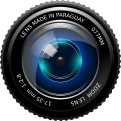What is Macro Photography?
A kind of photography known as macro includes getting up-close pictures of tiny features or things. Macro refers to the subject's magnification which is often recorded at a ratio of 1:1 or greater. This indicates that the subject's size in the photograph is equal to or greater than the subject's size in real life. From flowers and insects to common items and textures macro photography may be utilised to capture a variety of themes.
The Benefits of Macro Photography
Macro photography provides a unique perspective of the world and allows you to explore the intricate details of everyday objects and creatures. This type of photography encourages you to slow down focus on your subject and pay attention to the details that often go unnoticed. In addition to providing a new perspective macro photography is also a great way to improve your photography skills, as it requires technical precision and creativity.
Essential Equipment for Macro Photography
To get started with macro photography, you don't need a lot of expensive gear. However there are a few essential items you'll need to invest in to get the best results. These include:
A camera with manual controls: A camera with manual controls will give you more creative control over your shots and allow you to adjust settings like aperture, shutter speed and ISO.
A lens: To achieve true macro magnification, you'll need a macro lens. These lenses are designed specifically for close-up photography and offer a magnification ratio of at least 1:1. However, if you don't want to invest in a macro lens, you can use extension tubes, macro filters, or reversing rings to achieve a similar effect.
A tripod: Macro photography often requires slow shutter speeds to capture sharp images, so a tripod is essential to keep your camera steady and reduce camera shake.
A flash: A flash can be useful for illuminating your subject and reducing shadow, especially in low-light situations.
Techniques for Capturing Stunning Macro Photos
Now that you have your equipment it's time to start taking amazing macro photos. Here are some techniques to help you get started:
Focus stacking: Focus stacking is a technique that involves taking multiple photos of the same subject at different focus points and combining them in post-processing to achieve maximum depth of field. This is especially useful in macro photography where you want to capture both the foreground and background in focus.
Use a shallow depth of field: A shallow depth of field is a common technique in macro photography as it helps to isolate your subject and blur the background. You can achieve a shallow depth of field by using a wide aperture, such as f/2.8 or f/4.
Experiment with different angles: Macro photography allows you to get up close and personal with your subject so don't be afraid to experiment with different angles and perspectives. Try shooting from above, below, or at an angle to add interest and creative flair to your shots.
Pay attention to lighting: Lighting is crucial in macro photography, as it can make or break a shot. Pay attention to the direction and quality of light and adjust your settings accordingly. Natural light is often preferred for macro photography but if you're shooting in low light conditions, you may need to use a flash or set up artificial lighting to get the best results.
Pay attention to background: The background of your macro shot is just as important as the subject itself, so make sure it's clean and doesn't distract from the focus of your photo. Try shooting against a solid color background such as a piece of paper or fabric, or use selective focus to blur the background.
Use live view: Live view is a feature on most digital cameras that allows you to preview your shot on the LCD screen before you take the photo. This is especially helpful in macro photography as it allows you to see exactly what you're capturing and make any necessary adjustments.
Tips for Post-Processing Macro Photos
It's time to edit and improve your macro images when you've finished taking them. The following advice can help you get the greatest outcomes:
Crop your images to either highlight the topic or to get rid of any distracting objects.
Adjust the exposure so that the backdrop is correctly illuminated and the subject is properly lighted in your photographs.
Sharpness should be adjusted since macro photography frequently calls for a high level of sharpness. Doing so will help your images look more detailed.
Increase saturation: Macro shots typically benefit from this since the vibrant colors of the subject can enhance the image's overall impact.
Include a vignette: A vignette is a softening of a photograph's edges, which can assist in directing the viewer's attention to the image's topic and center.
A intriguing and satisfying subject that enables you to experience the world in a fresh and original way is macro photography. Whether you're a beginner or a seasoned photographer, using these tips and tricks will enable you to capture breathtaking macro images that will astound and inspire.

